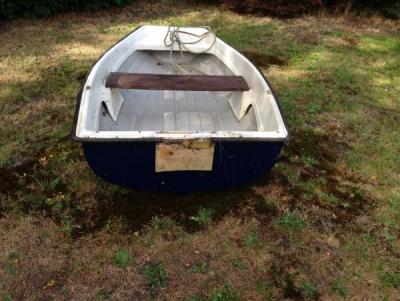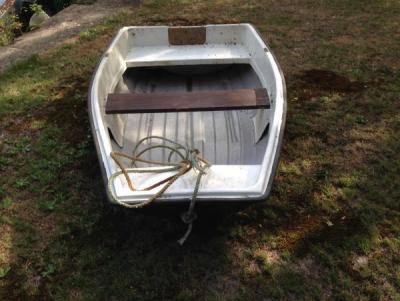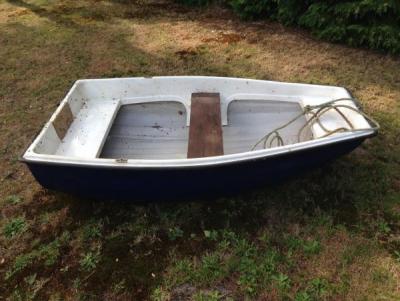-
Posts
5,200 -
Joined
-
Last visited
-
Days Won
40
Content Type
Profiles
Forums
Blogs
Events
Gallery
Everything posted by Coddy
-
Done
-
Hi Dave You can still dig for rag, the main concern is back filling the holes and it is a recommendation that you don't take more than 3lb of rag for your personal use every day. The Southern IFCA wardens may question you if you take more That's a lot of rag unless you know something we don't! Dave
-
NOW SOLD Having a clear out I have a fiberglass pram dingy for sale, no oars or rowlocks 6ft long 3' 8" wide Will fit in or on top of a car, easily handled by one person. Offers around £75 Mobile 07581 717211 Dave
-
I have a 535 and don't need any brakes as under 750kg Don't load the boat up with gear otherwise you may go over the limit. Dave
-
Hi all It was asked at a Wessex AT meeting about catching Undulate Rays and the AT stance on it for South Coast fisherman This was the reply: The Undulate Ray is a Prohibited Species in commercial fisheries - with no targeting, retaining, transhipping or landing of the ray permitted in ICES areas VI, VII, VIII, IX and X. The Undulate Ray is also a key marine species in the UK Biodiversity Action Plan (UK BAP), with management plans in place to encourage expansion of both range and population (http://www.sharktrust.co.uk/en/undulate_ray_results). With regards to the Angling Trust’s policy on Undulate ray they recommend “Undulate ray are classified as endangered. We recommend that all fish are returned alive” (http://www.anglingtrust.net/page.asp?section=163§ionTitle=Legal+Minimum+Landing+Sizes+For+Sea+Fish Dave
-
Brian I can drop it into you or wait until the next meeting Dave
-
untilPBSBAC 48hr Club Comp Best Specimen – per angler. From 6pm Friday to 6pm Sunday £5.00 entry – 1st, 2nd and Third prizes will be paid out ASAP after the competition
-
New Post started in Conservation thread Dave
-
Recreational sea angling within the District – Questionaire Southern IFCA are responsible for the sustainable management of inshore fisheries resources between Lyme Regis and Chichester Harbour, out to 6 nautical miles. One of our main work streams this year covers recreational sea angling. Sea angling is a major fishing sector in the District providing significant economic inputs to local communities. There are a number of areas of work associated with furthering the developments of the sector which we will be implementing over the coming years. As part of this process we are very keen on gathering opinions and information from sea anglers across the District and have developed this associated questionnaire. If you are an angler within the District or visit the Southern District for your recreational angling experience, please fill in the questionnaire and email it back to us: enquiries@southern-ifca.gov.uk. Many thanks for your time. Sea Angling Questionnaire – online Now is your chance as recreational anglers to have your say on how Southern IFCA can help anglers. We need as many people as possible to submit their thoughts and ideas As the saying goes USE IT OR LOOSE IT If you want the SIFCA page for the survey go here http://www.southern-...k/category/news
-
Happy Birthday Mick Hope you have a great day
-
Just did the survey, did not take long and as it has been said, it is your chance to suggest ways to improve recreational angling
-
Are there any tree surgeons in the club? If so could someone call or PM me to get a quote to reduce the height of some conifers in the garden Thanks Dave
-
Interesting article about smooth hounds http://www.treehugger.com/natural-sciences/irelands-smooth-hound-sharks-under-threat-from-troubled-fishing-practices.html I know it is a few years old now Dave
-
Identification: Elongated body with lateral compression. The snout is blunt and steep, with two long mobile barbels present on the chin of the lower jaw, and that maybe folded back into a grove on the underside of the fish. The upper jaw lacks teeth, and the cheeks have two rows of scales, above the low set mouth. The eyes are located in the top third of the head. The tail fin is deeply forked. Two dorsal fins present. The anterior dorsal fin has seven or eight membrane bound flexible spines, that are separate from the second dorsal fin, which is composed of one spine and seven to eight branched soft rays. The anal fin is very similar in shape to the second dorsal fin. The large scales of the head and body are easily detached and lost. Considerable changes in colouration occur depending upon the situation, such as the time of day, stress, condition of the fish, etc. The norm is that of a pink or reddish colour, with three or four yellow stripes running lengthwise along the sides, with a reddish brown stripe marking the lateral line. The belly is pale to white. Brown and yellow banding is to be seen on the anterior dorsal fin, and to a slight extent upon the second as well. The yellow banding of the sides tends to become mottled during the hours of darkness, and more overall yellow hue is taken on by the body. Breeding: Spawns over May through into July, with juveniles being surface feeders until they migrate down to the seafloor. Habitat: This bottom dwelling fish is to be found over sands and muds in small shoals, and favours inshore waters during the summer months, although it is not uncommon in rocky areas. Food: Uses it's barbels to search and locate benthic invertebrates such as crustaceans, worms, and molluscs, along with the occasional small fish. Range: Found throughout UK waters. Additional Notes: Mullus barbatus may, or may not be a separate species, but is rarer, and one of it's chief characteristics is that it lacks the yellow bands of Mullus surmuletus and only grows to about 30cm or so. It is to be found offshore, has shorter barbels, and occurs only rarely in the SW waters of the UK.
-
Mick If you get a chance I would suggest a few pictures, it helps the sale Dave
-
Be wary of these people as their prices can be steep for older models!
-
Looking at the pictures Willow Wind is the current name Have to spill loads of falling down water if you change the name!
-
The Poole Bay monster is alive ............................................................................... we need a bigger boat!
-
In the Fish ID gallery I have put up some detail info on the Scorpion Fish There are different species however.
-
Also know as: Bullhead, Short-spined Sea Scorpion, Bull-Rout, Rockfish, Clobberhead, Father-Lasher, Scorpionfish, Rock Sculpin, Short-horned Sculpin, Granny Fish Size: up to 18 inches in length and 2-3lbs, but most much smaller than this UK minimum size: 8ins/20cm UK shore caught record: 2lb 7oz Feeds on: Anything it can find including fish the same size as itself.Description: Small squat fish with very large head and mouth relative to its body size. Rest of scaleless body is thin and tapering. Two spiky dorsal fins with no gap between them. Spines on gill covers and head and small spikes running down the lateral line. Usually mottled brown/green in colour, but colour can vary greatly between fish. Belly is usually red in males and orange in females. The main species of sea scorpion found in UK waters is commonly called a bullhead or short-spined sea scorpion (Myoxocephalus scorpius). This species can be found in rocky ground, but also over sandy and muddy seabeds in depths down to fifty metres or so. It is an aggressive predator which feeds on fish, prawns, crustaceans or any other small marine animals which pass. It does not hunt prey as such but feeds as an ambush predator, waiting for prey to come past and then snapping at them. Its large mouth and fast digestive system (it can digest its own body weight in around an hour) allows it to feed on fish the same size as itself. Second Species of Sea Scorpion in UK Waters The other species of sea scorpion found in the UK is the long-spined sea scorpion (Taurulus bubalis). This species looks very similar to its bigger cousin but only grows to a maximum length of seven inches. It has two longer spines on each gill cover whereas Myoxocephalus scorpius has a higher number of shorter spines. A further difference is that the short spined has barbels on the edge of its mouth and these are absent on the long-spined. Angling for Sea Scorpion and Value to Humans Anglers do not target sea scorpion as such but they are often caught on bait meant for other species. They can take surprisingly large baits, including big squid and fish baits meant for cod! Sea scorpions are present in UK waters all year round but are caught slightly more often in summer when they come into shallower water and feed more actively. Smaller sea scorpions are often found trapped in rockpools by the outgoing tide. Like sharks, rays, mackerel and tuna the sea scorpion has no swim bladder and sinks as soon as it stops actively swimming. Due to their small size, unusual appearance and spines sea scorpions have absolutely no commercial value at all. They are, however, popular to keep in marine aquariums due to their striking appearance and aggressive behaviour when feeding.
-
Saw it on the way to its new home.
-
Happy Birthday Bill Hope you have a great day Dave
-
Poole Bay Small Boat Angling Club's Open Species Comp in conjuction with Dogfish Dave and Cobbs Marina Sign in on the day Weigh in at 6.00pm with photo's only
-

From Sunday 22nd til Weds 25th June - fishing marathon !
Coddy replied to Hooky's topic in Trip Planning
Suggest you keep clear of beer as the sea swell can have it's own effect on the body, plus it would be a shame to waste it over the side of a boat!







